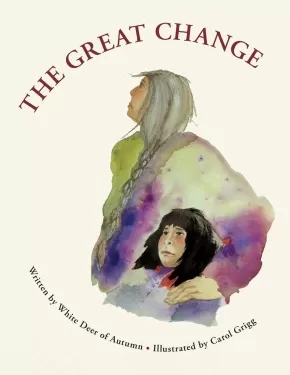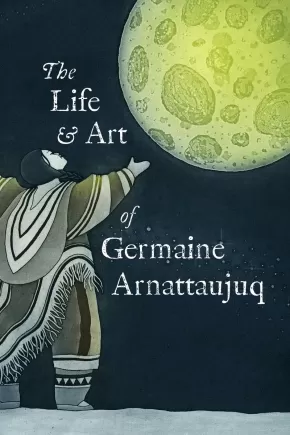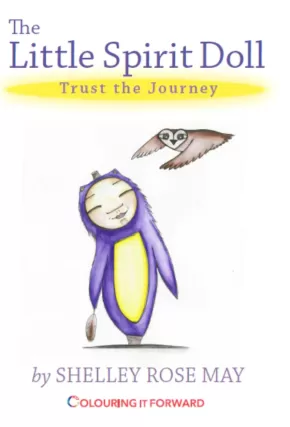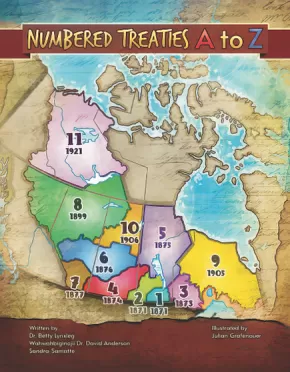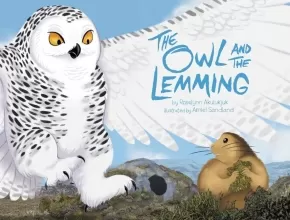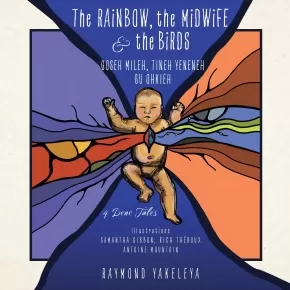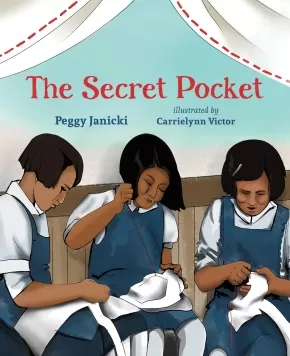
Indigenous Peoples
541
-
555
of
1572 Results;
Sort By
Go To
of 105
The Great Change
$14.99
Artists:
Format:
Paperback
Text Content Territories:
Indigenous American; Native American;
ISBN / Barcode: 9781582708928
Synopsis:
Synopsis:
What happens when we die? In this beautifully illustrated Native American tale, a wise grandmother explains their people's understanding of death to her granddaughter as they work together on the land, for which they show an exemplary respect and love.
In this Native American tale, a wise grandmother explains the meaning of death, or the Great Change, to her questioning granddaughter. While going through their daily tasks in the Native way, taking from Mother Earth only what is needed and returning what is not used so as to replenish her, nine-year-old Wanba asks, “Why do fish have to die? Why does anything have to die? Why did Grandpa have to die?” Grandmother explains that just as a caterpillar “dies” only to become a beautiful butterfly, there is no “death” in the Circle of Life—only the Great Change.
This is a story of passing on tradition, culture, and wisdom to the next generation. It is a moving tale for everyone—child and adult—who wonders about what lies beyond this life.
Reviews
A gentle and sensitive story about mortality and the interconnectedness of generations and of life-forms that provides a nondoctrinal, reassuring response to a child's questions about the necessity of death. Grigg's watercolors are spare, with washes of brilliant color (cheering a potentially somber subject) against pure white pages. The characters are not romanticized, but the overall effect is delicate and impressionistic." —Patricia Dooley, University of Washington, Seattle Grades 3–6, School Library Journal
This wistful text, based on a Native American tale, ponders the meaning of life and death—reaching the sensible if daunting conclusion that one is impossible without the other.…Delicate pastel watercolors capture the story's essence on gossamer wings with a pleasing combination of sophistication and childish impressibility. —Publisher's Weekly
Educator Information
Recommended for ages 6 to 12.
Additional Information
32 pages | 8.50" x 11.00" | Paperback
The Great Giants of the Arctic
$22.95
Artists:
Format:
Hardcover
Text Content Territories:
Indigenous Canadian; Inuit;
ISBN / Barcode: 9781774506608
Synopsis:
Synopsis:
“Long ago, there lived great giants in the Arctic.”
But where did they go? Learn all about the famous giants of the North, including Inukpasuksuk, Nuvuja, and others. Why do winds from the south bring warm weather? What happens when the giant in the sky gets upset? The Great Giants of the Arctic answers these questions and more using simple language for young readers to enjoy.
This stunningly illustrated bilingual picture book serves as an early-level introduction to the rich, mysterious world of Inuit mythology. Adapted by author and linguist Jaypeetee Arnakak with the intention of teaching Inuktitut as as a second language, The Great Giants of the Arctic can be enjoyed by Inuktitut language learners and curious young readers alike.
Educator Information
Recommended for ages 3 to 6.
Bilingual: Inuktitut and English
Additional Information
36 pages | 8.50" x 8.50"| Hardcover
The Land Outside My Window
$15.00
Artists:
Format:
Paperback
Text Content Territories:
Indigenous Canadian; First Nations; Dene; Yellowknives Dene (T'atsaot'ine);
ISBN / Barcode: 9781738119608
Synopsis:
Synopsis:
A young child stares out her window at spaces and places she has not had access to in the past, but that was about to change. Her teacher leads her to the Land, and through several children’s eyes, we see all that the Land can teach us.
Each place carries stories. The child wonders and poses many questions about the Land and the past as she wanders and plays with her friend discovering and learning together.
Educator Information
The author recommends this book for grades 3+.
Includes an Author's Note.
The Land Outside My Window was inspired by the work of many people across the Northwest Territories who envisioned on-the-Land programming as a possibility for all. Mahsi Cho for your vision and dedication.
Additional Information
30 pages
The Life and Art of Germaine Arnattaujuq
$15.95
Artists:
Format:
Paperback
Text Content Territories:
Indigenous Canadian; Inuit;
ISBN / Barcode: 9781774506462
Synopsis:
Synopsis:
Uncover the incredible life story of Germaine Arnattaujuq, a singularly important Inuit artist, in this high interest/low reading level reference book for struggling readers.
Germaine Arnattaujuq is an award-winning Inuit artist. This book tells the story of her life, from growing up at a camp in Nunavut to her education as an artist in Winnipeg and Ottawa and her eventual return to the North. Germaine's incredible drawings, etchings, and illustrations are featured throughout the book, along with archival photographs.
Filled with personal anecdotes and fun facts, this book encourages reluctant readers to discover how Germaine started drawing on gum wrappers as a child and went on to become one of the most well-known artists from the North.
Educator Information
Recommended for ages 12 to 18.
This is a Hi-Lo (high-interest, low readability) book.
Additional Information
60 pages | 6.00" x 9.00" | Colour Photographs | Paperback
The Little Folk
$18.95
Artists:
Format:
Hardcover
Text Content Territories:
Indigenous Canadian; Inuit;
ISBN / Barcode: 9781772274684
Synopsis:
Synopsis:
This traditional story, retold by Kugaaruk Elder Levi Illuitok, tells the tale of a Inuk boy who is adopted by little folk—a magical race of small Arctic people called inugarulliit. The boy’s adopted parents finally allow him to go hunting, where he catches a lemming. The little folk use their abilities to turn the lemming into a polar bear, and the catch is stored at their iglu. The boy’s parents are proud that their son can provide lots of meat to share with the community. This is a magical introduction to a traditional Inuit story for young readers.
Educator Information
Recommended for ages 6 to 8.
Additional Information
28 pages | 8.00" x 9.00" | Hardcover
The Little Spirit Doll: Trust the Journey
$17.00
Artists:
Format:
Paperback
Text Content Territories:
Indigenous Canadian; Métis;
ISBN / Barcode: 23-DF-053-1
Synopsis:
Synopsis:
The little spirit doll is made with clay and wood. The clay was taken without ceremony from her river bank home so the little spirit doll feels traumatized from being ripped from her home and feels that she has no name and no one who loves her. She goes on a journey to heal and with the help of friends and spirit guides, she finds her way.
This 40-page book contains illustrations that are gradually coloured in as the doll heals. It is a great way to teach children about trauma and healing.
Educator Information
Recommended for ages 7 to 10.
Additional Information
40 Pages | 8.5"x 6" | soft cover
The Most Amazing Bird (PB)
$10.99
Artists:
Format:
Paperback
Text Content Territories:
Indigenous Canadian; Inuit;
ISBN / Barcode: 9781773214177
Synopsis:
Synopsis:
A young girl discovers nature’s surprising beauty in this tale from a renowned Inuit storyteller.
When Aggataa goes for a cold winter walk with her grandmother, she’s surprised by a sudden CRAH! All the birds have flown south for the winter except one kind—the tulugarguat, the ravens. They’re the ugliest birds that Aggaataa has ever seen. They look like they slept in their coats—coats that don’t even fit! However, as the winter slowly moves towards spring, Aggataa connects with one small raven in particular.
As the seasons change in full, the ravens leave and are replaced by seagulls, cranes, geese, ducks, and swans—all of them far more elegant than the “Ugly Bird.” But where Aggataa once thought the ravens odd for visiting during the harshest part of the year, she now finds herself watching the horizon, waiting for the return of the most amazing bird.
This touching story by award-winning author Michael Arvaarluk Kusugak reminds us of our lasting connection to nature, while art by celebrated illustrator Andrew Qappik illuminates the enduring magic of the changing seasons.
Awards
- 2020 Top 10 Picture Books of the Year, The Globe and Mail joint winner
- 2020 Kirkus Best Books List joint winner
Reviews
“The illustrations enrich the text and celebrate the heartwarming message that nature is a wonderful gift that we can connect to and relish.”— Storywraps
“Stunningly contemporary and amazingly timeless.”— Kirkus Reviews
“Sparse illustrations of arctic flora and fauna against the unforgiving snow and ice make this picture book immersive.” — Foreword Reviews
Educator Information
Recommended for ages 4 to 7.
Michael's story is about connection to nature and each other.
The art in this story is an authentic depiction of the Arctic landscape and provides the Inuit names for the birds.
Additional Information
40 pages | 9.50" x 6.90" | Paperback
The Numbered Treaties A to Z
$24.95
Artists:
Format:
Paperback
Text Content Territories:
Indigenous Canadian;
ISBN / Barcode: 9781990297342
Synopsis:
Synopsis:
Let us walk together through the ABCs of the Numbered Treaties. We purposefully use the ABC, a constructed Language system from the English Language, to talk back to the Numbered Treaties, so named without reference to our Own Language system or the Land.
First Nations People entered into Treaties and Agreements prior to Confederation and negotiated the Numbered Treaties after the Confederation of Canada in 1867.
Educator Information
Recommended for grades 4 to 6.
Additional Information
Paperback
The Origin of Day and Night (PB)
$13.95
Artists:
Format:
Paperback
Text Content Territories:
Indigenous Canadian; Inuit;
ISBN / Barcode: 9781772274691
Synopsis:
Synopsis:
In very early times, there was no night or day and words spoken by chance could become real. When a hare and a fox meet and express their longing for light and darkness, their words are too powerful to be denied. Passed orally from storyteller to storyteller for hundreds of years, this beautifully illustrated story weaves together elements of an origin story and a traditional animal tale, giving young readers a window into Inuit mythology.
Educator Information
Recommended in a Canadian Indigenous Books for Schools resource list as being useful for grades 2-5 in these subject areas: English Language Arts, Social Studies.
Useful as a read-aloud, independent read, or information resource for students.
Additional Information
32 pages | 9.00" x 8.00" | Paperback
The Owl and the Lemming (PB)
$13.95
Artists:
Format:
Paperback
Text Content Territories:
Indigenous Canadian; Inuit;
ISBN / Barcode: 9781772274868
Synopsis:
Synopsis:
As Owl swoops down and blocks the entrance to a lemming den, he is sure that he has a tasty meal in the little animal he has cornered. But this lemming is not about to be eaten! This smart little rodent will need to appeal to the boastful owl's sense of pride to get away. This fun and cheeky tale is accompanied by full-colour still photographs of custom-built characters on a hand-built set.
Educator Information
This book is available in French: Le hibou et le lemming
Additional Information
36 pages | 9.00" x 7.00" | Paperback
The Princess and the Pants
 $19.95
$19.95

Artists:
Format:
Hardcover
Text Content Territories:
Indigenous Canadian; First Nations; Kwakwaka'wakw (Kwakiutl); Musgamagw Dzawada’enuxw;
ISBN / Barcode: 9781771746038
Synopsis:
Synopsis:
On the banks of the Gwa’yi River, a young Dzawada̱ʼenux̱w princess grows up to be a curious student, an influential leader, and a mother. She is a humble person and doesn’t speak of her royalty to her children, but when they learn she is a princess at a traditional celebration, they are in disbelief. She doesn’t wear fancy clothes or attend balls or do anything the children think princesses should do. Using a strategy they had read about in an old tale to put their mother’s royalty to the test, the children discover the truth. But more importantly, they also learn what it really means to be a princess.
Written as a tribute to the author’s grandmother, this beautifully illustrated story reimagines a fairy tale in a contemporary Indigenous setting.
Awards
- First Place: 2025 Sunshine Coast Writers and Editors Society Book Awards for BC Authors
- Longlisted: 2024-2025 First Nation Communities READ Award
Reviews
"The author was inspired by the fairy tale The Princess and the Pea by Hans Christian Anderson when she wrote this story to honour her grandmother. In this contemporary version, two children, while attending a traditional Indigenous celebration, are surprised to hear that their mother is a princess. She has never mentioned her royalty, and she doesn’t act the way the children think princesses generally behave. Remembering the story that told of placing a pea under mattresses to test if a person is a real princess, the children secretly place a pair of pants under their mother’s mattress and anxiously wait to hear if her sleep is affected. In the morning, they learn not only the truth, but also what it really means to be a princess.
Classroom Connections: The Princess and the Pants could be used in the classroom to compare different versions of fairy tales. It could also serve as a springboard into discussions about the personal qualities that the author wished to celebrate when she wrote this story. A short biographical note about Dr. Evelyn Voyageur—a notable Indigenous leader—is included. Beautiful illustrations depict aspects of a Kwakwaka’wakw culture." - Canadian Teacher Magazine, Fall 2023 issue
"A contemporary Indigenous spin on the Princess and the Pea, the picture book is suitable as a part of a fairy tale unit and a read-aloud to spark discussions about personal qualities and attributes, expectations, stereotypes, curiosity, the importance of helping others, and honouring traditions." - Focused Education Resources
“Loved the role modelling of the princess as one who represents adventure, cultural knowledge, and caring for others while finding achievement. The story promotes respect, admiration, humility, kindness, and honouring of a strong, successful female. The imaginative story is a fun challenge to princess stereotypes and classic related fairytales. The nonfiction content provides an enriching and personalized bonus that deepens the impact of the words and provides local significance. Well done. The illustrations are excellent, offering accurate and attractive cultural designs, clothing, head ware, and jewelry.” – The 2025 Sunshine Coast Writers and Editors Society judges’ panel
Educator Information
Recommended for ages 4 to 8.
Backmatter provides details about Ukwanalis, including a map, as well as information about the inspiration behind the story, Dr. Evelyn Voyageur.
Curriculum Connections
- Early Literacy – listening, reading, and discussing
- Art – traditional Indigenous art practices, including jewellery and regalia
- Social Studies – career education, family history, connection to community, geography, and local First Peoples communities
- Language Arts – contemporary First Peoples stories and revisioning classic fairy tales
- Social Responsibility – leadership, humility, caring for others, and honouring traditions
Additional Information
24 Pages | 8.5” x 11” | Hardcover | 9781771746038
The Rainbow, the Midwife, and the Birds: 4 Dene Tales
$29.95
Artists:
Format:
Paperback
Text Content Territories:
Indigenous Canadian; First Nations; Dene;
ISBN / Barcode: 9781988824574
Synopsis:
Synopsis:
The book contains four Dene stories, as told by Raymond Yakeleya. "Flight Through the Rainbow" is about flying through a rainbow in a small plane and experiencing multi-sensations of colour. It also tells the legend of the spider and how its web catches raindrops that create the rainbow. "The Midwife and the Spirit of Life," dedicated to Raymond's Granny Harriet Gladue, is about the birth of babies and bringing their spirits into the world. "The Slingshot and the Songbird" is about a boy's sadness over killing a friendly songbird. "The Medicine Brothers and the Giant Birds" is a tale told to Raymond by his uncle George Blondin about the hazards of giant animals when the world was new.
The book also contains Dene language translation of terms from the book.
Educator & Series Information
This book is recommended for ages 8 to 12.
This book is part of the Indigenous Spirit of Nature series.
Additional Information
48 pages | 8.50" x 8.50" | Paperback
The Raven Boy
$19.95
Artists:
Format:
Hardcover
Text Content Territories:
Indigenous Canadian; Inuit;
ISBN / Barcode: 9781772274943
Synopsis:
Synopsis:
In this retelling of an Inuit traditional story from the Western Arctic, a doll made by a poor old woman who is cast aside by her camp magically comes to life. The boy, with the beak of a raven from the materials the doll was crafted from, lives and is raised as the old woman’s son. When he is finally old enough to venture out on his own, he embarks on an epic journey to fight a beast from the depths of the ocean to create his own island world.
Educator Information
Recommended for ages 6 to 8.
Additional Information
32 pages | 9.50" x 9.50" | Hardcover
The Rights of Indigenous Peoples Explained
$27.99
Artists:
Format:
Hardcover
Text Content Territories:
Indigenous;
ISBN / Barcode: 9781738699315
Synopsis:
Synopsis:
Hey Child, I am excited to simplify the United Nations Declaration on the Rights of Indigenous Peoples (UNDRIP) for you. You are special and you deserve to know that the Indigenous People around you have rights. You should, at all times, respect and acknowledge their rights.
Educator Information
Recommended for ages 4 to 6.
Additional Information
40 pages | 8.50" x 11.00" | Hardcover
The Secret Pocket
$21.95
Artists:
Format:
Hardcover
Text Content Territories:
Indigenous Canadian; First Nations; Dene; Dakelh (Carrier);
ISBN / Barcode: 9781459833722
Synopsis:
Synopsis:
The true story of how Indigenous girls at a Canadian residential school sewed secret pockets into their dresses to hide food and survive
Mary was four years old when she was first taken away to the Lejac Indian Residential School. It was far away from her home and family. Always hungry and cold, there was little comfort for young Mary. Speaking Dakelh was forbidden and the nuns and priest were always watching, ready to punish. Mary and the other girls had a genius idea: drawing on the knowledge from their mothers, aunts and grandmothers who were all master sewers, the girls would sew hidden pockets in their clothes to hide food. They secretly gathered materials and sewed at nighttime, then used their pockets to hide apples, carrots and pieces of bread to share with the younger girls.
Based on the author's mother's experience at residential school, The Secret Pocket is a story of survival and resilience in the face of genocide and cruelty. But it's also a celebration of quiet resistance to the injustice of residential schools and how the sewing skills passed down through generations of Indigenous women gave these girls a future, stitch by stitch.
Awards
- 2023 Sunshine Coast Writers and Editors Society (SCWES) Book Awards for BC Authors joint winner
- 2024 Forest of Reading Silver Birch Express Award
Reviews
“In bringing her mother’s story to the world, Peggy Janicki has ignited a powerful fire for intergenerational healing. A vivid illustration of how Traditional Knowledge helped the children at residential schools be heroes for themselves and each other. Not only has Janicki meticulously documented everyday life as experienced by the students of the Lejac residential school but she has also highlighted their ingenious and courageous efforts to survive. Strengths-based, age-appropriate and vividly engaging.”— Christy Jordan-Fenton, award-winning author of Fatty Legs
“Beautifully illustrated and powerfully narrated, The Secret Pocket amplifies the voices and experiences of Indian Residential School Survivors. In doing so, Peggy Janicki and Carrielynn Victor make an important contribution to the work of putting truth before reconciliation.”— Sean Carleton, historian and author of Lessons in Legitimacy: Colonialism, Capitalism, and the Rise of State Schooling in British Columbia
“In this important story of courage and resistance, educator Peggy Janicki shares the story of her mother and other Survivors who sewed secret pockets into their dresses to hide food to feed themselves and others at Lejac residential school. We need to continue to hear these stories and share them with our children so we can move forward in our collective healing.”— Dr. Sara Florence Davidson, co-author of Potlach as Pedagogy: Learning Through Ceremony
“It is through stories that knowledge, understanding, empathy and the tools for deep and lasting change are passed on. Peggy Janicki has carried her mother’s story for us to hold in our hearts. This truth-telling and history-sharing will touch readers of all ages as they allow themselves to feel the weight of this powerful book.”— Amber Price, MGC, owner of The Book Man
Educator Information
Recommended for ages 6 to 8.
This book is available in French: La poche secrète.
Additional Information
32 pages | 8.75" x 10.75" | Hardcover
Sort By
Go To
of 105

